

Nas4Free and ZFS Tuning for 16gb Ram. This is my ZFS Config changes to smooth out network spikes with 16gb tested on both 64bit nas4free and 64bit openindiana 151a7 (openindiana/solaris are better at autotuning some of these settings; on these OS’s step 1 is not required). 1.
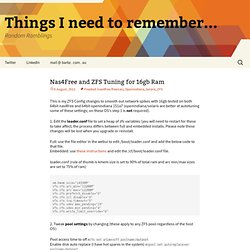
Edit the loader.conf file to set a heap of zfs variables (you will need to restart for these to take affect; the process differs between full and embedded installs. Please note these changes will be lost when you upgrade or reinstall. Full: use the file editor in the webui to edit /boot/loader.conf and add the below code to that file. Embedded: use these instructions and edit the /cf/boot/loader.conf file. loader.conf (rule of thumb is kmem size is set to 90% of total ram and arc min/max sizes are set to 75% of ram) ZFSTuningGuide - FreeBSD Wiki. See also: Solaris: ZFS Evil Tuning Guide, loader.conf(5), sysctl(8).
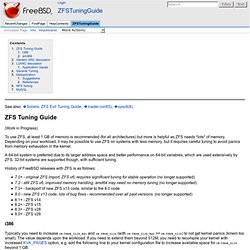
ZFS Tuning Guide (Work in Progress) To use ZFS, at least 1 GB of memory is recommended (for all architectures) but more is helpful as ZFS needs *lots* of memory. Depending on your workload, it may be possible to use ZFS on systems with less memory, but it requires careful tuning to avoid panics from memory exhaustion in the kernel. A 64-bit system is preferred due to its larger address space and better performance on 64-bit variables, which are used extensively by ZFS. 32-bit systems are supported though, with sufficient tuning.
History of FreeBSD releases with ZFS is as follows: 7.0+ - original ZFS import, ZFS v6; requires significant tuning for stable operation (no longer supported) 7.2 - still ZFS v6, improved memory handling, amd64 may need no memory tuning (no longer supported) 7.3+ - backport of new ZFS v13 code, similar to the 8.0 code 8.0 - new ZFS v13 code, lots of bug fixes - recommended over all past versions. . #! Creating and Destroying ZFS Storage Pools - Oracle Solaris ZFS Administration Guide. The following sections describe different scenarios for creating and destroying ZFS storage pools: Creating and destroying pools is fast and easy.
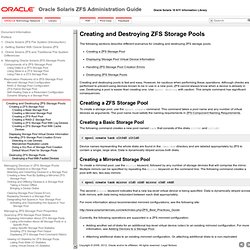
However, be cautious when performing these operations. Although checks are performed to prevent using devices known to be in use in a new pool, ZFS cannot always know when a device is already in use. Destroying a pool is easier than creating one. Use zpool destroy with caution. Creating a ZFS Storage Pool To create a storage pool, use the zpool create command. Creating a Basic Storage Pool The following command creates a new pool named tank that consists of the disks c1t0d0 and c1t1d0: # zpool create tank c1t0d0 c1t1d0 Device names representing the whole disks are found in the /dev/dsk directory and are labeled appropriately by ZFS to contain a single, large slice. Creating a Mirrored Storage Pool To create a mirrored pool, use the mirror keyword, followed by any number of storage devices that will comprise the mirror. ZFS. Créez votre propre serveur de cloud avec Syncbox. 1.
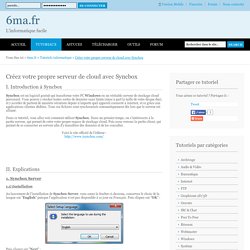
Syncbox Server 1.1) Installation Au lancement de l'installation de Syncbox Server, vous aurez la fenêtre ci-dessous, conservez le choix de la langue sur "English" puisque l'application n'est pas disponible à ce jour en Français. Puis cliquez sur "OK" : Puis cliquez sur "Next" : Poursuivez l'installation (classique) jusqu'à obtenir la fenêtre ci-dessous : Cliquez sur "Finish" pour lancer Synbox Server afin de pouvoir le configurer. 1.2) Configuration Dans la fenêtre qui s'est ouverte, cochez "Custom Install" puis cliquez sur "Next" Dans la fenêtre suivante, sélectionnez la partition qui sera utilisée pour votre serveur de données (cloud), c'est à dire là ou seront stockées toutes les données envoyées et synchronisées entre vos différents appareils.
Dans la fenêtre suivante, vous trouverez votre ID Syncbox, c'est à dire l'identifiant avec lequel vous allez pouvoir vous connecter côté client depuis vos ordinateurs, smartphones, navigateurs web. OpenMediaVault. The installation images can be found here.
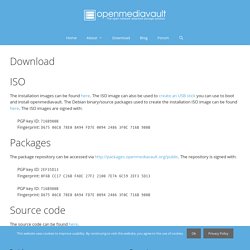
The ISO image can also be used to create an USB stick you can use to boot and install openmediavault. The Debian binary/source packages used to create the installation ISO image can be found here.
OwnCloud. Run your own Personal Cloud.